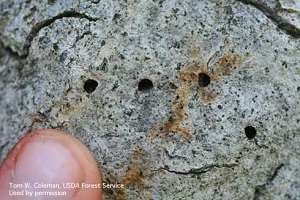By Mary Louise Flint
Over the last several decades, dozens of exotic pests have invaded California landscapes, causing at least temporary havoc and sometimes severely affecting the aesthetic value of plants or even killing them.

Three bark beetles of concern to landscapers and gardeners are described in the following paragraphs. For information on these and other exotic pests see the web sites of the UC Riverside Center for Invasive Species Research, the California Department of Food and Agriculture, or the UC Statewide IPM Program.
Goldspotted Oak Borer
First identified in eastern San Diego County in 2004, the goldspotted oak borer, Agrilus auroguttatus, has killed over 25,000 California native red oaks since its arrival and has now been detected in Riverside County. Larvae feed deep within the phloem, and adults are rarely seen. Infestations are recognized by the presence of D-shaped exit holes on trees, often accompanied by bark staining and crown decline. There are currently no good ways to manage the pest in moderate to severely infested trees. Contact your agricultural commissioner if you find infestations outside the known infested area. More information is available at http://www.ipm.ucanr.edu/PMG/PESTNOTES/pn74163.html.
Walnut Twig Beetle and Thousand Cankers Disease